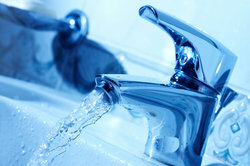L / s in m3 / s
Even if you will have to do with the flow rate relatively infrequently in theory, it may be these still play a role for you in practice from time to time, for example when it comes to your bathtub goes. So that you do not get confused with the units during the calculation, you can very easily convert the two units l / s and m3 / s.

The flow rates l / s and m3/ s
The units liters per second (l / s) and cubic meters per second (m3/ s) is used.
- As you may still know from your school days, one cubic meter corresponds to a cube with edge lengths of one meter each.
- In order to convert cubic meters into another, metric unit, you also have to take the conversion factor to the power of three, since this is applied to each of the three sides.
- So if you want to go from cubic meters to cubic decimeters, for example, you have to use the conversion factor 1,000, which corresponds to 10x10x10.
- Since 1964 it has also been standardized that one cubic decimeter corresponds exactly to one liter. This means that you can use the conversion factor between cubic decimeters and cubic meters, i.e. one liter is exactly 0.001 cubic meters or 1 cubic meter corresponds exactly to 1,000 liters.
- So if you want to convert the flow rate from liters per second to cubic meters per second, you only need to divide the output value by the factor.
- If the flow rate should be 3.5 l / s, for example, this would be 0.0035 m3/ s resp. 3.5 dm3/ s
Cubic Meters to Liters - Explanation
Both liters and cubic meters are volume specifications. As a result, the two ...
Practical example of the flow rate calculation
Even if it may seem at first glance that you will never use the flow rate calculation in practice, it can be very useful in everyday life.
- For example, you could easily find out how long it would take to fill your bathtub with water.
- A normal standard bathtub usually has a capacity of 140 liters and the tap has a flow rate of approximately 0.25 l / s.
- This means that in one minute 15 liters (0.25 x 60) and in one hour 900 liters (0.25 x 60 x 60) would flow through your faucet.
- If you now divide the 140 liters by the flow rate of 15 l / m, you get 9.333 minutes, i.e. 9 minutes and 20 seconds.
How helpful do you find this article?


